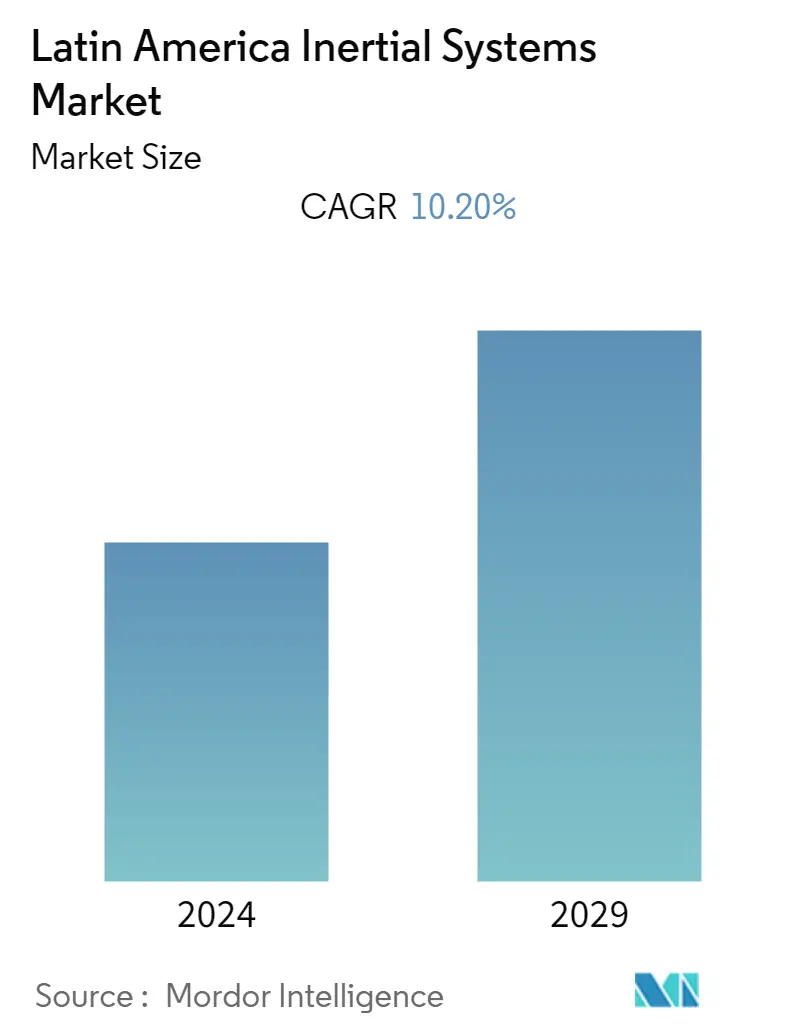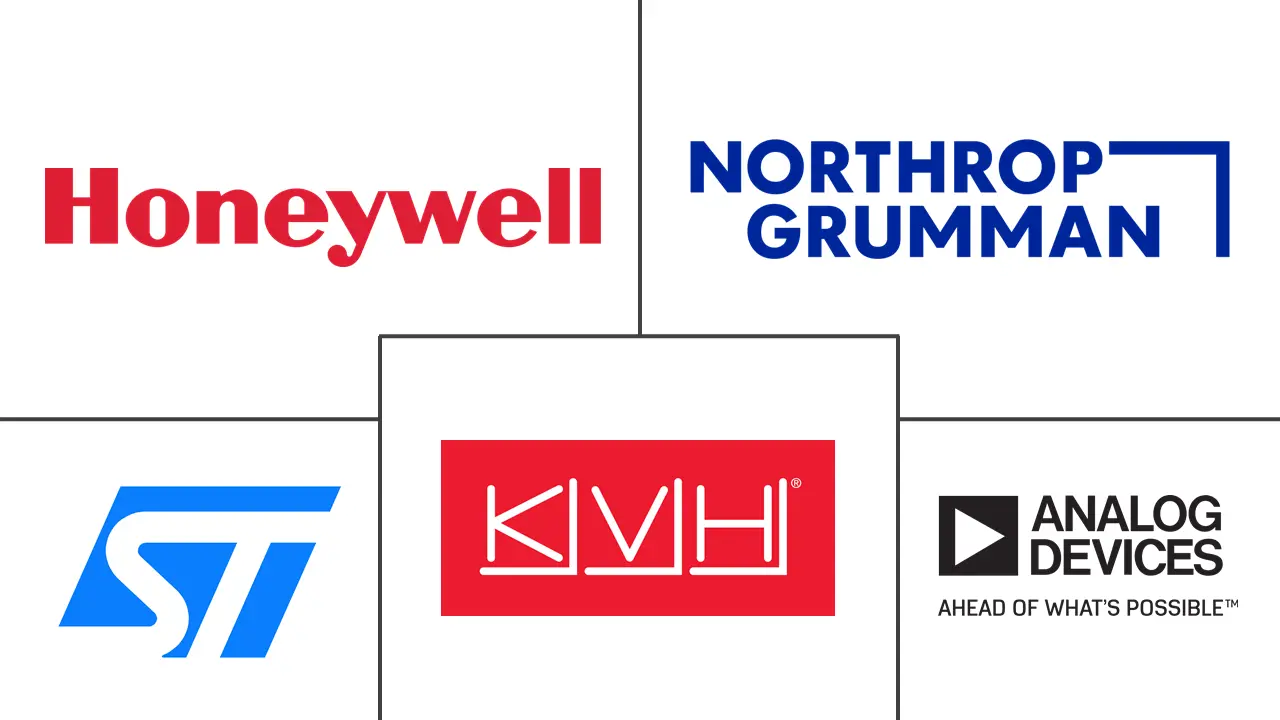
| Study Period | 2019 - 2029 |
| Base Year For Estimation | 2023 |
| Forecast Data Period | 2024 - 2029 |
| Historical Data Period | 2019 - 2022 |
| CAGR | 10.20 % |
| Market Concentration | Medium |
Major Players
*Disclaimer: Major Players sorted in no particular order |
Latin America Inertial Systems Market Analysis
The Latin America Inertial Systems Market is expected to register a CAGR of 10.2% during the forecast period from 2021 to 2026. The Latin American inertial systems market is expected to grow significantly, owing to rising opportunities in defense and aerospace.
- The rise of low-cost airlines is expected to boost market opportunities. According to Boeing, the market demand for flight operations services in the aerospace industry in 2017 was USD 1,870 million and is expected to rise to USD 4,975 million by 2035.
- Increased decentralization in global affairs and increased defense budgets are expected to drive market growth. The defense sector has numerous inertial systems applications like Missile Guidance, Precision Guided Munitions, Control and Targeting, Tank Turret Stabilization, and Torpedo Guidance.
- Further, the addition of microelectromechanical systems, or MEMS technology, has broadened market opportunities. The technology is widely used in field sensors and semiconductors. Small-diameter missiles, underwater navigators, and unmanned underwater vehicles also increase demand for high-end MEMS sensors in the defense sector. The growing modernization of weaponry with the advent of smart weapons and advanced tanks is also an essential driver for the market.
- The rapid advancement in technology and compels the market players to innovate new products with advanced features. Strategic collaborations and partnerships which enable companies to leverage their synergies are also on the rise. For instance, in October 2021, Thales Group partnered with CS Group to develop a comprehensive cyber-secure navigation system for use on naval surface ships. The collaboration brings together Thales' expertise in inertial navigation systems and CS Group's experience in smart cyber-protected mission-critical systems.
- Moreover, Inertial sensors are used in biomedical instruments extensively for their multi-function characteristics. The inertial systems are increasingly being used in medical equipment, including MRI devices, intelligent patient beds, surgical robots, and angiography equipment. Government initiatives like the Plan Nacer in Argentina have been immensely successful and popular in the country. The tax-funded Unified Health System has changed the healthcare system in Brazil. With Columbia establishing the right to healthcare in its constitution, among many other plans, overhauled the healthcare system in the region. As the healthcare sector widens in Latin America, it would also propel the inertial systems market.
Latin America Inertial Systems Industry Segmentation
The Latin America Inertial Systems Market is Segmented By Equipment (Gyroscopes, Accelerometers, Inertial Measurement Units, GPS/INS, Multi-Axis Sensors), By Technology (MEMS, Fiber Optic Gyro, Ring Laser Gyro, Vibrating Gyro, Hemispherical Resonator Gyro, Mechanical Inertial Navigational Systems), By End-user Industry (Automotive, Defense, Industrial OEM, energy & infrastructure, Civil Aviation).
An inertial system or an inertial navigation system (INS) is a navigation device that utilizes a computer, motion sensors (accelerometers), and rotation sensors (gyroscopes) to continuously calculate the position, orientation, and velocity (direction and speed of movement) of a moving object by dead reckoning. A barometric altimeter frequently supplements inertial sensors and, on occasion, magnetic sensors (magnetometers) and speed measuring devices.
| Gyroscopes |
| Accelerometers |
| Inertial Measurement Units |
| GPS/INS |
| Multi-Axis Sensors |
| MEMS |
| Optic Fibre Gyro |
| Ring Laser Gyro |
| Vibrating Gyro |
| Hemispherical Resonator Gyro |
| Mechanical Inertial Navigational Systems |
| Automotive |
| Defense |
| Industrial |
| OEM |
| Energy and Infrastructure |
| Civil Aviation |
| Brazil |
| Mexico |
| Colombia |
| Argentina |
| Rest of Latin America |
Latin America Inertial Systems Market Size Summary
The Latin America Inertial Systems Market is poised for significant growth, driven by increasing opportunities in the defense and aerospace sectors. The expansion of low-cost airlines is expected to further enhance market prospects. The defense industry, with its diverse applications of inertial systems such as missile guidance and tank turret stabilization, is a major contributor to market growth. Additionally, the integration of microelectromechanical systems (MEMS) technology has opened new avenues, particularly in defense applications like small-diameter missiles and unmanned underwater vehicles. The modernization of weaponry and the development of smart weapons are also key factors propelling the market. Strategic collaborations, such as Thales Group's partnership with CS Group, highlight the industry's focus on innovation and cyber-secure navigation systems. Furthermore, the healthcare sector's expansion in Latin America, supported by government initiatives, is increasing the use of inertial systems in medical equipment, thereby contributing to market growth.
The demand for unmanned underwater vehicles (UUVs) is a significant driver of market expansion, particularly in oil and gas exploration activities in the region. UUVs are utilized in various defense and scientific research applications, enhancing their market appeal. Technological advancements, including light-powered navigation systems, are positively influencing the market outlook. Despite the challenges posed by the COVID-19 pandemic, which temporarily disrupted supply chains and trade, the market remains resilient. The automotive industry also plays a crucial role, with inertial sensors improving vehicle safety and performance. Major players like Honeywell International Inc. and ST Microelectronics are actively expanding their global presence and introducing innovative products, such as Honeywell's Precision Boresight Alignment System and STMicroelectronics' Teseo-VIC3DA navigation module. These developments underscore the competitive nature of the market and the ongoing efforts to meet the rising demand for advanced inertial systems across various sectors.
Latin America Inertial Systems Market Size - Table of Contents
1. MARKET DYNAMICS
-
1.1 Market Drivers
- 1.1.1 Emergence of MEMS Technology
- 1.1.2 Increasing Demand for Accuracy in Navigation
-
1.2 Market Restraints
- 1.2.1 Integration Drift Error in Navigational Systems
- 1.2.2 Increasing Costs and Complexity
2. MARKET SEGMENTATION
-
2.1 By Equipment
- 2.1.1 Gyroscopes
- 2.1.2 Accelerometers
- 2.1.3 Inertial Measurement Units
- 2.1.4 GPS/INS
- 2.1.5 Multi-Axis Sensors
-
2.2 By Technology
- 2.2.1 MEMS
- 2.2.2 Optic Fibre Gyro
- 2.2.3 Ring Laser Gyro
- 2.2.4 Vibrating Gyro
- 2.2.5 Hemispherical Resonator Gyro
- 2.2.6 Mechanical Inertial Navigational Systems
-
2.3 By End-user Industry
- 2.3.1 Automotive
- 2.3.2 Defense
- 2.3.3 Industrial
- 2.3.4 OEM
- 2.3.5 Energy and Infrastructure
- 2.3.6 Civil Aviation
-
2.4 By Country
- 2.4.1 Brazil
- 2.4.2 Mexico
- 2.4.3 Colombia
- 2.4.4 Argentina
- 2.4.5 Rest of Latin America
Latin America Inertial Systems Market Research FAQs
What is the current Latin America Inertial Systems Market size?
The Latin America Inertial Systems Market is projected to register a CAGR of 10.2% during the forecast period (2025-2030)
Who are the key players in Latin America Inertial Systems Market?
Honeywell International Inc., KVH Industries Inc., Northrop Grumman Corporation, ST Microelectronics and Analog Devices Inc. are the major companies operating in the Latin America Inertial Systems Market.


